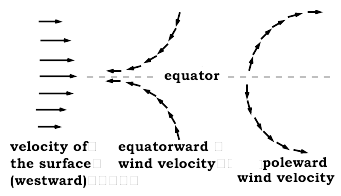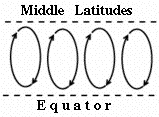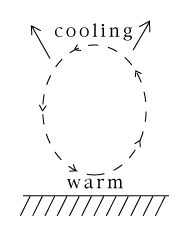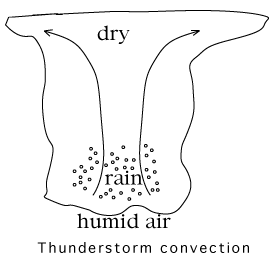|
Heat is absorbed (mostly) by the ground. Furthermore, heating is most intense near the equator, where the Sun's rays come down most steeply. Slanting rays spread their heating over a wide area, but steep rays don't.
Heat is lost from Earth by being radiated back to space, as infra-red light. Anything warm or hot emits radiation--visible light for very hot objects (such as the Sun), infra-red light for moderately warm ones--but warm or hot, they shine away heat. That can happen almost equally well anywhere on Earth.
So... spreading out the heat arriving near the equator helps return it to space, allowing the entire atmosphere to participate in its return. This yields a more efficient disposal of heat, and that is what global atmospheric flows try to achieve. We say "flow of heat" but what actually flows (as in any convection) is air -- warm air towards the poles, cooled air towards the equator.
As such flows take place, the rotation of the Earth enters the picture (this was discussed in section #24, but is repeated here). Air at the equator, rotating with the Earth, moves eastward at more than 400 m/sec. As air flows poleward, it gets closer to the Earth axis, to where the surface moves more slowly (the rotation velocity drops to zero at the pole). Because of its inertia, the flowing air retains at least some of its greater speed and overtakes the rotation of the Earth. Thus motion which started by heading polewards gradually slants eastwards (drawing below--right-hand flow).

Ultimately that air cools down, and perhaps it also loses its extra eastward velocity (all or some of it) to friction with the ground. Now it must return to the equator, pushed out by some other mass of air, newly arrived from equatorial latitudes. As it approaches the equator, the ground below it is moving eastward faster, so that by inertia, the returning air lags behind it. If it started flowing directly equatorward, this lagging causes its flow to slant westward (drawing above--left-hand flow).
The result is similar to the one found in section #24, in discussing the Coriolis effect. North of the equator, both drawn sections tend to circulate clockwise; south of the equator the circulation is counterclockwise.

As the bible already stated (quote at the beginning of this section), every flow in the atmosphere is a closed circulation. So as a very simplified picture, one can visualize the flow north of the equator as a series of clockwise loops:
But there is more to the global picture.
The Earth is round, and on a global scale, all these motions transfer momentum. They transfer eastward momentum from the equator to middle latitudes, and since momentum is conserved (Newton's 3rd law--"every action has an equal and opposite reaction") an equal westward momentum is transferred to the equatorial region.
The overall effect is an eastward flow of air (winds blowing from the west or "westerlies") at middle latitudes, and a westward flow of air ("easterlies" blowing from the east) in the equatorial region
The westerlies dominate weather in the 48 states of the continental USA and in Europe. Winds may blow from the northwest or southwest, reflecting waves in the flow due to the circulations drawn above, but generally they come from "somewhere in the west." The fastest flow in this great stream (as in any river) is in its middle, and there the air flows fastest at high altitudes, say 30,000. That fast core flow is known as the jetstream, well known from weather maps--providing welcome tailwinds for airliners heading eastwards and being avoided (as much as possible) by westbound flights. Weather forecasters like to show the jetstream, because its location marks the general position of the much larger eastward flow. And its often show a wavelike shape.
In the age of sailing ships, sea-captains took advantage of this system. Sailing from Spain to America, they would go closer to the equator, a more southern route that took advantage of the easterly "trade winds." Sailing back home they would venture further north and use the westerlies. The many Spanish wrecks off Florida, some with quite rich cargo, were lost to storms on this home voyage back to Spain. Those ships were loaded with gold and silver from Mexico and South America, and followed the coast of Florida northward before turning westward towards Europe.
Postscript: Clockwise loops north of the equator? Don't hurricanes rotate the opposite way? They indeed do. However, hurricanes are associated with hot humid water getting rid of its humidity in the form of rain, a somewhat different process.
.
Water vapor
Instead of heating the Earth, sunlight can evaporate water from it--especially from the oceans, which cover most of the Earth's surface. Humid air may be viewed as containing additional energy, invested by the Sun when its heat evaporated the water. While heat drives convection, humidity may amplify it.
Hot humid air is what drives thunderstorms, and a warm ocean surface is also the traditional birthplace of violent tropical storms, known as hurricanes in America and typhoons in Asia.
| 


 We look at two examples of humidity in action.
We look at two examples of humidity in action.